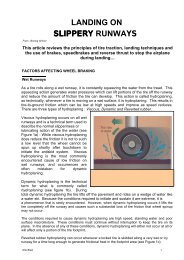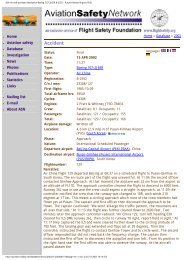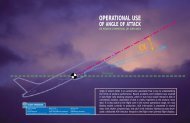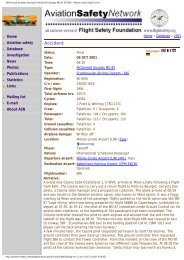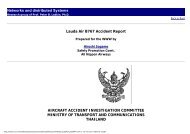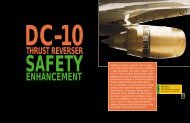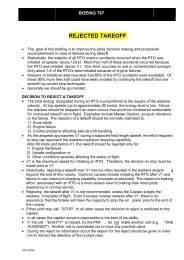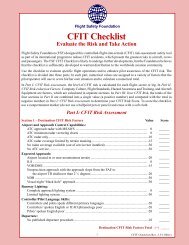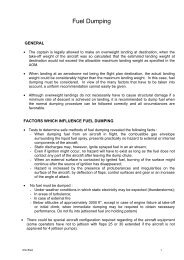Boeing 737-236 series 1, G-BGJL: Main document - Leonardo
Boeing 737-236 series 1, G-BGJL: Main document - Leonardo
Boeing 737-236 series 1, G-BGJL: Main document - Leonardo
You also want an ePaper? Increase the reach of your titles
YUMPU automatically turns print PDFs into web optimized ePapers that Google loves.
The purser returned to the R1 door, lifted the slide pack in order to close the slide container lid, and<br />
cleared the obstruction.He succeeded in opening the door about 1 minute 10 seconds after the<br />
aircraft stopped and again confirmed the automatic inflation of the slide by pulling the manual<br />
inflation handle. Evacuation was carried out from this exit supervised by the purser.<br />
Smoke emanating from the cabin quickly reached the galley area and became rapidly more dense<br />
and acrid. When the smoke began to threaten severe incapacitation, the forward cabin crew vacated<br />
the aircraft by the slides at their respective doors.<br />
As the aircraft came to a halt and at the instigation of otherpassengers, a young woman sitting in<br />
row 10 seat F (10F), beside the right overwing exit, attempted to open it by pulling on her right hand<br />
arm-rest which was mounted on the exit hatch. Her companionin seat 10E, the centre seat of a row<br />
of three, stood up and reached across to pull the handle located at the top of the hatch<br />
marked "Emergency Pull". The hatch, weighing 48 lbs, fell into the aircraft, pivoting about its lower<br />
edge to lay across thepassenger in 10F, trapping her in her seat. With the assistance of a man in row<br />
11 behind the women, the hatch was removed and placed on vacant seat 11D. The passengers in 10F<br />
and 10E then left the aircraft cabin through the overwing exit onto the wing followed by other<br />
survivors. This exit was open about 45 seconds after the aircraft stopped.<br />
During the latter stages of the abandoned take-off, and just as the aircraft turned towards taxiway<br />
link Delta, the right rear(R2) door was seen by external witnesses to be open, with the slide<br />
deployed and inflated. A stewardess was initially visible in the doorway but the door and slide were<br />
obscured by thick blacksmoke as the aircraft stopped. No one escaped through this door.Two<br />
passengers remember seeing one of the two stewardesses from the rear of the aircraft struggling to<br />
direct passengers in the rear aisle. Neither rear stewardess survived.<br />
The left rear (L2) door was opened by firemen some time afterthe fire had been extinguished.<br />
In total, 17 surviving passengers escaped through the L1 door, 34 through the R1 door and 27<br />
through the overwing exit including1 infant and 1 child in arms.<br />
The air and ground movements controllers in the tower had seen the fire and smoke trailing behind<br />
the aircraft (Appendix 4) and had initiated 'full emergency' action. The air controller activated the<br />
alarm siren connected directly to the aerodrome fire servicestation (Manchester International<br />
Airport Fire Service - MIAFS),and gave brief details of the emergency to the MIAFS<br />
watchroom over the direct telephone link. The ground movements controller alerted the emergency<br />
telephone operator at the Manchester International Airport Exchange.<br />
Members of the MIAFS who were on duty at the time, heard a bang and saw an aircraft decelerating<br />
on runway 24. Black smoke and flames were trailing from the left side of the aircraft and the firemen<br />
had already initiated their response when the crash alarmsiren sounded.<br />
Two Rapid Intervention Vehicles (RIVs) attended first, one arriving at the aircraft coincident with,<br />
the other just after the L1 doorhad opened and its slide deployed, as passengers were about to start<br />
to evacuate. About 30 to 40 seconds later, as two major foam tenders took up position, the R1 door<br />
was opened fully and its slide deployed.<br />
The MIAFS vehicles were positioned in order to attempt to keepthe escape routes clear of fire, and<br />
to attack the source of thefire.<br />
A British Airways crew coach arrived at the accident site after about 4 minutes, carrying a Tristar<br />
cabin crew, who rendered first aid and comfort to the survivors and later to an injured fireman.They<br />
also led the survivors away from the aircraft and onto coachesfor transportation to a suitable<br />
holding area, and then on to hospital. Other ramp and airport authority vehicles also attended.



